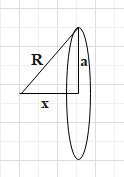
An infinite, uniformly charged sheet with surface charge density $\sigma $ cuts through a spherical Gaussian surface of radius R at a distance x from its centre, as shown in the figure. The electric flux $\Phi $ through the Gaussian surface is:

$\begin{align}
& \text{A}\text{. }\dfrac{\pi {{R}^{2}}\sigma }{{{\varepsilon }_{0}}} \\
& \text{B}\text{. }\dfrac{2\pi \left( {{R}^{2}}-{{x}^{2}} \right)\sigma }{{{\varepsilon }_{0}}} \\
& \text{C}\text{. }\dfrac{2\pi {{\left( R-x \right)}^{2}}\sigma }{{{\varepsilon }_{0}}} \\
& \text{D}\text{. }\dfrac{\pi \left( {{R}^{2}}-{{x}^{2}} \right)\sigma }{{{\varepsilon }_{0}}} \\
\end{align}$

Answer
577.5k+ views
Hint: Gauss’s law gives the total electric flux through a closed surface containing charges as the charge divided by the permittivity of free space. In this question we have the gaussian surface and the charged sheet. Since, we have the surface charge density, we can find the total charge enclosed by the surface by finding the area of the charged sheet inside the gaussian sphere. Then we can find the total electric flux using Gauss’s law.
Complete answer:
Gauss’s theorem states that the total electric flux through a closed surface is equal to the total charge enclosed by the surface divided by the permittivity of free space.
Electric flux can be defined as the measure of electric field lines passing through a given surface normal to the electric field.
From Gauss’s law, we can mathematically express it as,
$\Phi =\dfrac{Q}{{{\varepsilon }_{0}}}$
Where, $\Phi $ is the electric flux, Q is the total enclosed charge and ${{\varepsilon }_{0}}$ is the permittivity of free space.
In the given question, we will apply the gauss's law to find the electric flux through the given surface.
We need to find the total charge enclosed by the gaussian surface.
Charge density of the sheet is $\sigma $ .
The area of the sheet enclosed by the gaussian surface will be circular. The radius of the circular sheet will be,
$a=\sqrt{{{R}^{2}}-{{x}^{2}}}$

So, the area of the circular sheet inside the gaussian sphere will be,
$A=\pi {{a}^{2}}=\pi \left( {{R}^{2}}-{{x}^{2}} \right)$
The charge enclosed by the gaussian surface is,
$\begin{align}
& Q=\sigma A \\
& Q=\pi \left( {{R}^{2}}-{{x}^{2}} \right)\sigma \\
\end{align}$
So, according to the Gauss’s law, the electric flux through the gaussian surface will be,
$\Phi =\dfrac{Q}{{{\varepsilon }_{0}}}=\dfrac{\pi \left( {{R}^{2}}-{{x}^{2}} \right)\sigma }{{{\varepsilon }_{0}}}$
So, the correct answer is “Option D”.
Note:
Integral form of the Gauss’s law can be given as the area integral of the electric field over any closed surface is equal to the total charge enclosed by the surface divided by the permittivity of free space. We can mathematically express it as,
$\oint{\vec{E}.d\vec{A}=\dfrac{Q}{{{\varepsilon }_{0}}}}$
Complete answer:
Gauss’s theorem states that the total electric flux through a closed surface is equal to the total charge enclosed by the surface divided by the permittivity of free space.
Electric flux can be defined as the measure of electric field lines passing through a given surface normal to the electric field.
From Gauss’s law, we can mathematically express it as,
$\Phi =\dfrac{Q}{{{\varepsilon }_{0}}}$
Where, $\Phi $ is the electric flux, Q is the total enclosed charge and ${{\varepsilon }_{0}}$ is the permittivity of free space.
In the given question, we will apply the gauss's law to find the electric flux through the given surface.
We need to find the total charge enclosed by the gaussian surface.
Charge density of the sheet is $\sigma $ .
The area of the sheet enclosed by the gaussian surface will be circular. The radius of the circular sheet will be,
$a=\sqrt{{{R}^{2}}-{{x}^{2}}}$

So, the area of the circular sheet inside the gaussian sphere will be,
$A=\pi {{a}^{2}}=\pi \left( {{R}^{2}}-{{x}^{2}} \right)$
The charge enclosed by the gaussian surface is,
$\begin{align}
& Q=\sigma A \\
& Q=\pi \left( {{R}^{2}}-{{x}^{2}} \right)\sigma \\
\end{align}$
So, according to the Gauss’s law, the electric flux through the gaussian surface will be,
$\Phi =\dfrac{Q}{{{\varepsilon }_{0}}}=\dfrac{\pi \left( {{R}^{2}}-{{x}^{2}} \right)\sigma }{{{\varepsilon }_{0}}}$
So, the correct answer is “Option D”.
Note:
Integral form of the Gauss’s law can be given as the area integral of the electric field over any closed surface is equal to the total charge enclosed by the surface divided by the permittivity of free space. We can mathematically express it as,
$\oint{\vec{E}.d\vec{A}=\dfrac{Q}{{{\varepsilon }_{0}}}}$
Recently Updated Pages
A man running at a speed 5 ms is viewed in the side class 12 physics CBSE

The number of solutions in x in 02pi for which sqrt class 12 maths CBSE

State and explain Hardy Weinbergs Principle class 12 biology CBSE

Write any two methods of preparation of phenol Give class 12 chemistry CBSE

Which of the following statements is wrong a Amnion class 12 biology CBSE

Differentiate between action potential and resting class 12 biology CBSE

Trending doubts
What are the major means of transport Explain each class 12 social science CBSE

Which are the Top 10 Largest Countries of the World?

Draw a labelled sketch of the human eye class 12 physics CBSE

Explain sex determination in humans with line diag class 12 biology CBSE

Explain sex determination in humans with the help of class 12 biology CBSE

Differentiate between homogeneous and heterogeneous class 12 chemistry CBSE




